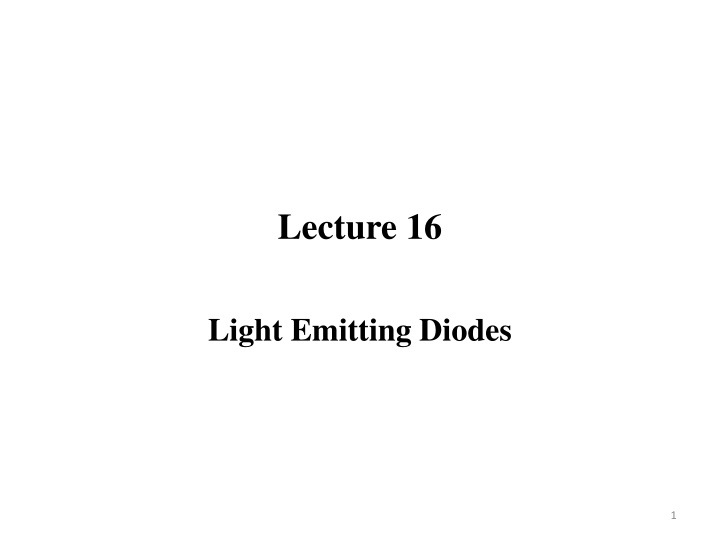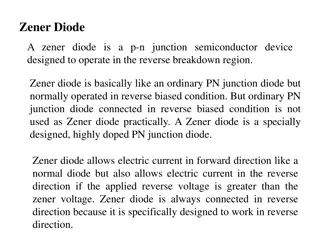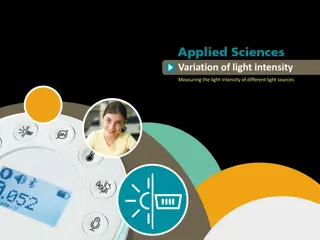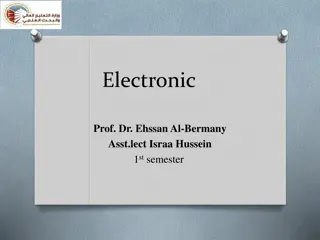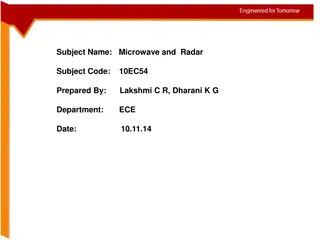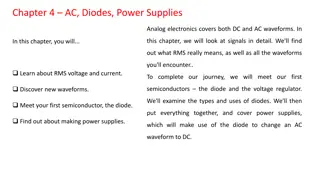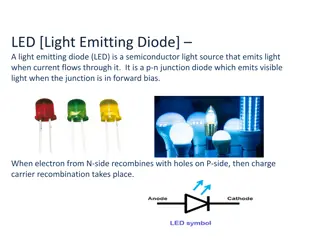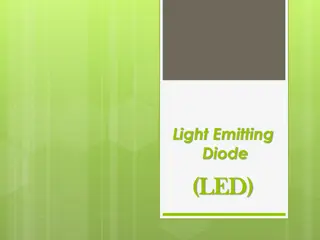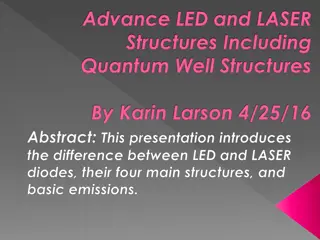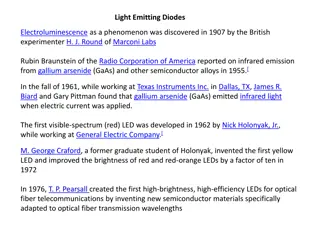Light Emitting Diodes
Light Emitting Diodes (LEDs) are optical semiconductor devices that convert electrical energy into light energy through electro-luminance. This technology works on the principle of recombination of charge carriers in semiconductor layers, resulting in light emission. LEDs consist of three main layers - n-type semiconductor, p-type semiconductor, and an active region - which play a crucial role in their construction and operation based on the quantum theory. The recombination of charge carriers occurs in the p-type material, leading to light emission when the device is forward biased.
Download Presentation

Please find below an Image/Link to download the presentation.
The content on the website is provided AS IS for your information and personal use only. It may not be sold, licensed, or shared on other websites without obtaining consent from the author.If you encounter any issues during the download, it is possible that the publisher has removed the file from their server.
You are allowed to download the files provided on this website for personal or commercial use, subject to the condition that they are used lawfully. All files are the property of their respective owners.
The content on the website is provided AS IS for your information and personal use only. It may not be sold, licensed, or shared on other websites without obtaining consent from the author.
E N D
Presentation Transcript
Lecture 16 Light Emitting Diodes 1
Recap When a current-carrying semiconductor or metal is kept in a magnetic field, the charge carriers of the semiconductor experience a force in a direction perpendicular to both the magnetic field and the current. At equilibrium, a voltage appears at the semiconductor edges. In a conductor, the electric field is produced due to the negatively charged free electrons. So the hall voltage produced in the conductor is negative. In the n-type semiconductor, the electric field is primarily produced due to the negatively charged free electrons. So the hall voltage produced in the n-type semiconductor is negative. In the p-type semiconductor, the electric field is primarily produced due to the positively charged holes. So the hall voltage produced in the p-type semiconductor is positive. 2
Light Emitting Diode (LED) A light Emitting Diode (LED) is an optical semiconductor device that emits light when voltage is applied. In other words, LED is an optical semiconductor device that converts electrical energy into light energy. LED (Light Emitting Diode) works on the principle of electro-luminance. Electro- luminance is the property of the material to convert electrical energy into light energy and later it radiates this light energy. In the same way, the semiconductor in LED emits light under the influence of electric field. Like the normal p-n junction diodes, LEDs also operates only in forward bias condition. 3
Construction of LED One of the methods used to construct LED is to deposit three semiconductor layers on the substrate. The three semiconductor layers deposited on the substrate are n- type semiconductor, p-type semiconductor and active region. Active region is present in between the n-type and p-type semiconductor layers 4
Construction of LED The recombination of the charge carrier occurs in the P-type material, and hence P- material is the surface of the LED. For the maximum emission of light, the anode is deposited at the edge of the P-type material. The cathode is made of gold film, and it is usually placed at the bottom of the N-region. This gold layer of cathode helps in reflecting the light to the surface. 5
Working of LED The working of the LED depends on the quantum theory. The quantum theory states that when the energy of electrons decreases from the higher level to lower level, it emits energy in the form of photons. The energy of the photons is equal to the gap between the higher and lower level. 6
Working of LED In LED, the p and n regions are forward biased. It operates like any other forward biased junction diode. But the material from which it is composed differentiates it from the ordinary one. When a forward voltage is applied to the PN junction diode. Then, the electrons start diffusing into the p region by experiencing repulsion from the battery. So, the electrons move from conduction band to valence band in order to combine with the holes. As we know, the conduction band is the higher energy level and valence band is the lower energy level. Hence, during this recombination, some energy is emitted by the electrons. 7
Working of LED When Light Emitting Diode (LED) is forward biased, the free electrons from n-side and the holes from p-side are pushed towards the junction. When free electrons reach the junction or depletion region, some of the free electrons recombine with the holes in the positive ions. We know that positive ions have less number of electrons than protons. Therefore, they are ready to accept electrons. Thus, free electrons recombine with holes in the depletion region. In the similar way, holes from p-side recombine with electrons in the depletion region. 8
Working of LED Because of the recombination of free electrons and holes in the depletion region, the width of depletion region decreases. As a result, more charge carriers will cross the p-n junction. Some of the charge carriers from p-side and n-side will cross the p-n junction before they recombine in the depletion region. For example, some free electrons from n-type semiconductor cross the p-n junction and recombines with holes in p-type semiconductor. In the similar way, holes from p-type semiconductor cross the p-n junction and recombines with free electrons in the n-type semiconductor.Thus, recombination takes place in depletion region as well as in p-type and n- type semiconductor. The free electrons in the conduction band releases energy in the form of light before they recombine with holes in the valence band. In silicon and germanium diodes, most of the energy is released in the form of heat and emitted light is too small. However, in materials like gallium arsenide and gallium phosphide the emitted photons have sufficient energy to produce intense visible light. 9
Working of LED LED is made of GaAs, GaAsP, GaP. As these materials exhibit the property of releasing energy in the form of radiation. While in Si or Ge diodes, energy liberation is done in the form of heat. Therefore, LED emits the energy in the form of photons, thereby producing light. The reason for possessing this special property by these materials is that these semiconductor materials have a direct band gap. This means a direct recombination is seen between electrons and holes and the emitted energy emerges in the form of light. LED is not operated in reverse biased mode as it cannot tolerate reverse bias voltage and can lead to its destruction. 10
How LED emits light? When external voltage is applied to the valence electrons, they gain sufficient energy and breaks the bonding with the parent atom. The valence electrons which breaks bonding with the parent atom are called free electrons. The energy level of free electrons in the conduction band is high compared to the energy level of valence electrons or holes in the valence band. Therefore, free electrons in the conduction band need to lose energy in order to recombine with the holes in the valence band. The free electrons in the conduction band do not stay for long period. After a short period, the free electrons lose energy in the form of light and recombine with the holes in the valence band. Each recombination of charge carrier will emit some light energy. The energy loss of free electrons or the intensity of emitted light depends on the forbidden gap or energy gap between conduction band and valence band. The semiconductor device with large forbidden gap emits high intensity light whereas the semiconductor device with small forbidden gap emits low intensity light. 11
How LED emits light? In other words, the brightness of the emitted light is depends on the material used for constructing LED and forward current flow through the LED. In normal silicon diodes, the energy gap between conduction band and valence band is less. Hence, the electrons fall only a short distance. As a result, low energy photons are released. These low energy photons have low frequency which is invisible to human eye. In LEDs, the energy gap between conduction band and valence band is very large so the free electrons in LEDs have greater energy than the free electrons in silicon diodes. Hence, the free electrons fall to a large distance. As a result, high energy photons are released. These high energy photons have high frequency which is visible to human eye 12
Output characteristics of LED The amount of output light emitted by the LED is directly proportional to the amount of forward current flowing through the LED. More the forward current, the greater is the emitted output light. The graph of forward current vs output light 13
What determines the color of an LED? The material used for constructing LED determines its color. In other words, the wavelength or color of the emitted light depends on the forbidden gap or energy gap of the material. Different materials emit different colors of light. Gallium arsenide LEDs emit red and infrared light. Gallium nitride LEDs emit bright blue light. Yttrium aluminium garnet LEDs emit white light. Gallium phosphide LEDs emit red, yellow and green light. Aluminium gallium nitride LEDs emit ultraviolet light. Aluminum gallium phosphide LEDs emit green light. 14
Advantages of LED 1.The brightness of light emitted by LED is depends on the current flowing through the LED. Hence, the brightness of LED can be easily controlled by varying the current. This makes possible to operate LED displays under different ambient lighting conditions. 2.Light emitting diodes consume low energy. 3.LEDs are very cheap and readily available. 4.LEDs are light in weight. 5.Smaller size. 6.LEDs have longer lifetime. 7.LEDs operates very fast. They can be turned on and off in very less time. 8.LEDs do not contain toxic material like mercury which is used in fluorescent lamps. 9.LEDs can emit different colors of light. 15
Disadvantage and Applications Disadvantages of LED 1.LEDs need more power to operate than normal p-n junction diodes. 2.Luminous efficiency of LEDs is low. Applications of LED 1.Burglar alarms systems 2.Calculators 3.Picture phones 4.Traffic signals 5.Digital computers 6.Multimeters 7.Microprocessors 8.Digital watches 9.Automotive heat lamps 10.Camera flashes 16
Symbol of LED The symbol of LED is formed by merging the symbol of P-N Junction diode and outward arrows. These outward arrows symbolise the light radiated by the Light emitting diode. The symbol of LED is described in the diagram below, the same symbol is used in electronics circuits. Above figure shows a slight variation in the symbol from an ordinary diode. This variation is nothing but the 2 outward arrows that shows the emission of radiation through the device. 17
LED PN junction diode The LED emits light. The PN junction diode cannot emit light. The LED uses GaAs, GaAsP or GaP material. The PN junction diode silicon or germanium material. In PN junction diode all energy converted into a heat. In LED all energy converted into a light Its on-state voltage drop is 0.7 V for silicon diode and 0.3 V for germanium diode. It s on state voltage ranges between 1.2 V to 2.0 V. It has very low value of reverse breakdown voltage. It has high value of reverse breakdown voltage. It is used as a light source in fiber optics, as an indicator in 7 segment displays etc. It is used in rectifiers, clippers, clamping, voltage multipliers etc. 18
Summary Like the normal p-n junction diodes, LEDs also operates only in forward bias condition. A Light Emitting Diode (LED) consists of three layers: p-type semiconductor, n-type semiconductor and depletion layer. The p-type semiconductor and the n-type semiconductor are separated by a depletion region or depletion layer. In LEDs, the energy gap between conduction band and valence band is very large so the free electrons in LEDs have greater energy than the free electrons in silicon diodes. LEDs can emit different colors of light due to different wave lenght. 19
